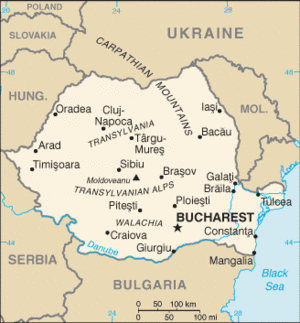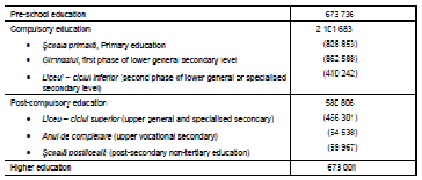Welcome to the Virtual Education Wiki ~ Open Education Wiki
Romania
Partners and Experts in Romania
None.
Romania in a nutshell
Romania (archaic: Rumania, Roumania; Romanian: România) is a country located in Southeastern and Central Europe, north of the Balkan Peninsula, on the Lower Danube, within and outside the Carpathian arch, bordering on the Black Sea. Almost all of the Danube Delta is located within its territory. It shares a border with Hungary and Serbia to the west, Ukraine and the Republic of Moldova to the northeast, and Bulgaria to the south.

The territory's recorded history includes periods of rule by Dacians, the Roman Empire, the Kingdom of Hungary, and the Ottoman Empire. As a nation-state, the country was formed by the merging of Moldavia and Wallachia in 1859 and it gained recognition of its independence in 1878. Later, in 1918, they were joined by Transylvania, Bukovina and Bessarabia. At the end of World War II, parts of its territories (roughly the present day Moldova) were occupied by the USSR and Romania became a member of the Warsaw Pact. With the fall of the Iron Curtain in 1989, Romania started a series of political and economic reforms. After a decade of post-revolution economic problems, Romania made economic reforms such as low flat tax rates in 2005 and joined the European Union on January 1, 2007. While Romania's income level remains one of the lowest in the European Union, reforms have increased the growth speed. Romania is now an upper-middle income country economy.
Romania has the 9th largest territory and the 7th largest population (with 21.5 million people) among the European Union member states.
Its capital and largest city is Bucharest (Romanian: Bucureşti), the 6th largest city in the EU with 1.9 million people.
In 2007, Sibiu, a city in Transylvania, was chosen as a European Capital of Culture.
Romania also joined NATO on March 29, 2004, and is also a member of the Latin Union, of the Francophonie of the OSCE and an associate member of the CPLP.
Romania is a semi-presidential unitary state.
Education in Romania
(sourced from http://en.wikipedia.org/wiki/Romania)
According to the Law on Education adopted in 1995, the education system is regulated by the Ministry of Education and Research. Each level has its own form of organization and is subject to different legislation.
- Kindergarten is optional for children between 3 and 6 years old.
- Schooling starts at age 7 (sometimes 6), and is compulsory until the 10th grade (which usually corresponds to the age of 17 or 16).[111] Primary and secondary education are divided into 12 or 13 grades.
- Higher education is aligned with the European higher education area.
Aside from the official schooling system, and the recently-added private equivalents, there exists a semi-legal, informal, fully private tutoring system. Tutoring is mostly used during secondary as a preparation for the various examinations, which are notoriously difficult. Tutoring is widespread, and it can be considered a part of the Education System. It has subsisted and even prospered during the Communist regime.
In 2010/11, total of enrolled population was 4 029 226 with the following distribution by level of education (2):
The results of the PISA assessment study in schools for the year 2000 placed Romania on the 34th rank out of 42 participant countries with a general weighted score of 432 representing 85% of the mean OECD score.
Romanian high school curricula have recently been censored and restructured, owing to a growing trend of religious conservatism. In 2006, the theory of evolution, which had been taught since the country's Communist era, was dropped from the compulsory curriculum nationwide. Philosophical writers critical of religion, such as Voltaire and Camus have also been removed from the philosophy curriculum.
For more details see http://en.wikipedia.org/wiki/Romanian_educational_system but note the caveats.
There is an authoritative recent report at http://siteresources.worldbank.org/INTROMANIA/Resources/EducationPolicyNote.pdf
Schools in Romania
A complete list of schools in Romania is provided by Romaniaschool.com
Wikipedia provides also a list of Secondary schools in the country at http://en.wikipedia.org/wiki/List_of_secondary_schools_in_Romania
Further and Higher Education
Post-secondary education
Post-secondary non-tertiary education (învăţământ postliceal) is provided by post-secondary schools (şcoala postliceală) and by foremen schools (şcoala de maiştri). It consists of 1 to 3 years of study and is organised at the initiative of the Ministry of Education, Research, Youth and Sports or following the specific requests of companies and other interested institutions. Post-secondary non-tertiary education ensures training of specialised technicians and foremen (Level 3 of Advanced Qualification) to work within specific domains according to their qualification.
Post-secondary non-tertiary education is usually organised by the education institutions which have technological high school classes – in the same or close profile and specialisations, in order to make a better use of the existing material basis (equipment, workshops, and other resources) and human resources and to improve financial efficiency. According to the provisions of the Education Law, tuition fees are required for post-secondary non-tertiary education and are paid by the students and/or by companies, institutions, etc. requesting this type of education. Tuition fees are established by the educational institutions and have to cover all education and training related costs. The post-secondary non-tertiary education schools can also establish registration fees for covering admission related costs.
Higher Education
Since 2005, the higher education system in Romania has been organised in three cycles and aligned with the Bologna Process: first degree (Bachelor) programmes, master programmes and PhD (doctorate) programmes compatible with the European qualification framework and laid out in Law 288 of 2004.
Students who have graduated from an upper secondary institution are eligible to apply for admission to a first degree programme according to the admission methodology of each university and study programme. Admission generally depends on student performance at the national examination at the end of upper secondary education (called Bacalaureat), performance in upper secondary school and performance at the university entrance examination. Higher education is mainly public, but also private. The Romanian higher education system includes 56 public universities, 30 private accredited universities, and 20 private authorized universities.
source Eurydice
Universities in Romania
(sourced from http://en.wikipedia.org/wiki/Romanian_educational_system - note that the article is very critical of universities as well as of schools)
The first modern Romanian universities were:
- University of Iaşi (founded 1860)
- University of Bucharest (founded 1864)
- Babeş-Bolyai University, Cluj (founded 1872)
Now there are many universities in the country, both public and private - see http://en.wikipedia.org/wiki/List_of_universities_in_Romania
Around 40 have Wikipedia entries - see http://en.wikipedia.org/wiki/Category:Universities_in_Romania
According to the Academic Ranking of World Universities, in 2006 no Romanian university was included in the first 500 top universities world wide. Using similar methodology to these rankings, it was reported that the best placed Romanian university, Bucharest University, attained the half score of the last university in the world top 500.
Polytechnics in Romania
Education reform
Schools
Post-secondary
The Bologna Process
Administration and finance
Schools
Post-secondary
Higher Education
The Romanian Agency for Quality Assurance in Higher Education was established in 2005 One major change has been that universities are now less strictly controlled by the Ministry of Education, Research, Youth and Sports. However, in every university growing autonomy should be accompanied by the development of a quality assurance system that safeguards the quality of university education and highlights differences between universities in terms of educational performance. Universities are very much aware that their appeal among students is largely determined by their ability to deliver tangible results. Furthermore, Romanian universities are implementing an effective quality assurance system in order to prepare for future competition with other universities. From this perspective, the main principles of Romanian quality assurance system focus on:
- the European Dimension, characterized by the integration in the European Higher Education Area of all Romanian higher education institutions;
- institutional responsibility, considered as a concept based on the principle of academic autonomy;
- institutional diversity, guaranteed through the external quality evaluation of all study programmes;
- cooperation of all the components of the education system as parts of a whole system;
- a performance-based system, by reference to the position obtained in quality assurance/evaluation;
- institutional identity, by influencing good practices and successful structures in the field of academic quality;
- internal institutional self-evaluation, as universities present the specificity of the quality culture through self-evaluation reports, continuous performance improvements;
- external evaluation, by monitoring the results reported by universities, through analysis of performance and relationship with the stated institutional reality (including student activities, conformity to the stated standards);
- improvement of quality – the main objective of all higher education institutions and, therefore, of the Romanian quality assurance system.
Quality assurance, inspection and accreditation
Schools
At the national level of the education system, the quality assurance strategy is implemented by the Romanian Agency for Quality Assurance in School Education - ARACIP.
This agency is responsible for:
- external evaluation of the quality of education offered by schools;
- authorisation, accreditation and evaluation schools.
The purpose of the external evaluation is mainly (i) to certify the capacity of the schools to meet the quality standards, (ii) to play a role in the development of a 'culture of quality' in school education institutions, and (iii) to recommend policies and strategies to the Ministry of Education, Research, Youth and Sports in order to improve the quality of education.
Post-secondary
Information society
ICT in education initiatives
Virtual initiatives in schools
Virtual initiatives in post-secondary education
Interesting Programmes
CODECS Romania
The Open University Business School has been offering courses in Romania for almost fifteen years in partnership with The Centre for Open Distance Education for the Civil Society (CODEDS), a major provider of management education in Romania. CODECS aim to provide a high quality and internationally recognised programme of management education for active managers in the emerging free market economy.
The internationally recognised Master of Business Administration (MBA), presented in English, provides opportunities for networking locally at regular seminars and internationally, both at residential schools and online, with managers studying the programme around the world. Seminars are presented by CODECS and OU Business School lecturers who have management and business experience. There are 151 MBA alumni in Romania.
The Open University Business School's Professional Certificate and Professional Diploma in Management programmes are presented in Romanian through a network of twelve Regional Centres across Romania. Each year over a thousand students study these programmes; many students then progress onto the MBA Programme.
Polytechnic University of Timisoara
The Polytechnic University of Timisoara (Universitatea 'Politehnica' din Timişoara) is located in Timişoara, Romania. Founded in 1920, it is one of the largest technical universities in Central/ Eastern Europe. The university has 10 faculties and several independent departments.
The Polytechnic University of Timisoara is the co-ordinator of the ViCaDiS (the Virtual Campus for Digital Students) project of the Erasmus Lifelong Learning Programme.
The Polytechnic University of Timisoara web site is at http://www.upt.ro/english/index.php
The Regional Distance Education Centre (CSID) has been, since 1998, a department of the Polytechnic University of Timisoara which aims to organise, support and supervise all distance education in the university.
The web site is at http://www.csid.upt.ro
Re.ViCa Case-study
None.
Lessons learnt
General lessons
Notable practices
References
- Eurydice National system overview on education systems in Europe, December 2011
- Eurybase, The Information Database on Education Systems in Europe: The Education System in Romania, 2008/09
- Good reference to elearning situtaion in Romania: http://www.eenovate.info/documents/Paths%20of%20Developing%20E-learning%20Programmes%20in%20Romania.pdf
